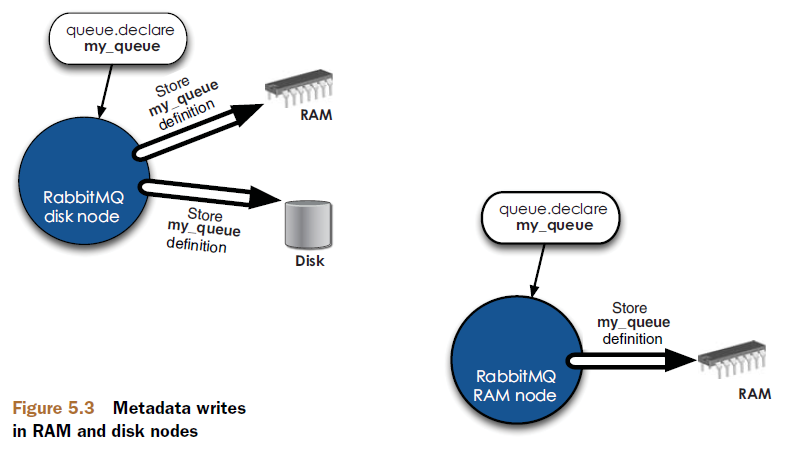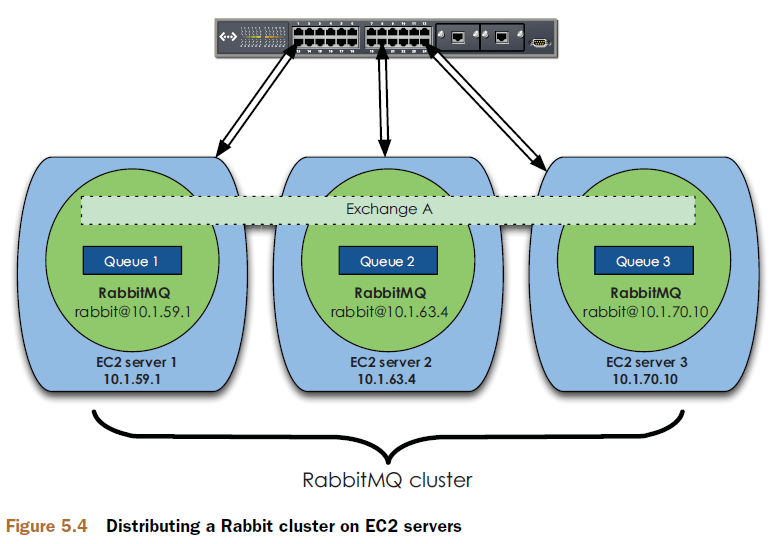RabbitMQ in Action(5): Clustering and dealing with failure
Batteries included: RabbitMQ clustering
The clustering built in to RabbitMQ was designed with two goals in mind: allowing consumers and producers to keep running in the event one Rabbit node dies, and linearly scaling messaging throughput by adding more nodes.
RabbitMQ adeptly satisfies both requirements by leveraging the Open Telecom Platform (OTP) distributed communication framework provided by Erlang.
when a Rabbit cluster node dies, the messages in queues on that node can disappear. This is because RabbitMQ doesn’t replicate the contents of
queues throughout the cluster by default. Without specific configuration, they live only on the node that owns the queue.
Architecture of a cluster
RabbitMQ is keeping track of four kinds of internal metadata:
- Queue metadata—Queue names and their properties (are they durable or autodelete?)
- Exchange metadata—The exchange’s name, the type of exchange it is, and what the properties are (durable and so on)
- Binding metadata—A simple table showing how to route messages to queues
- Vhost metadata—Namespacing and security attributes for the queues, exchanges, and bindings within a vhost
For clustering, RabbitMQ now has to keep track of a new type of metadata: cluster node location and the nodes’ relationships to the other types of metadata already being tracked.
Queues in a cluster
Only the owner node for a queue knows the full information(metadata, state, contents) about that queue.
All of the non-owner nodes only know the queue’s metadata and a pointer to the node where the queue actually lives.

when a cluster node dies, that node’s queues and associated bindings disappear. Consumers attached to those queues lose their subscriptions, and any new messages that would’ve matched that queue’s bindings become black-holed.
You can have your consumers reconnect to the cluster and recreate the queues, only if the queues weren’t originally marked durable.
If the queues being re-created were marked as durable, redeclaring them from another node will get you an ugly 404 NOT_FOUND error.
The only way to get that specific queue name back into the cluster is to actually restore the failed node.
if the queues your consumers try to re-create are not durable, the redeclarations will succeed and you’re ready to rebind them and keep trucking.
Distributing exchanges
unlike queues which get their own process, exchanges are just a name and a list of queue bindings.
When you publish a message “into” an exchange, what really happens is the channel you’re connected to compares the routing key on the message to the list of bindings for that exchange, and then routes it.
an exchange is simply a lookup table rather than the actual router of messages
when you create a new exchange, all RabbitMQ has to do is add that lookup table to all of the nodes in the cluster. Every channel on every node then has access to the new exchange.
So where the full information about a queue is by default on a single node in the cluster, every node in the cluster has all of the information about every exchange.
what happens to messages that have been published into a channel but haven’t finished routing yet when the node fails?
The basic.publish AMQP command doesn’t return the status of the message.
The solution is to use an AMQP transaction, which blocks until the message is routed to a queue, or to use publisher confirms to keep track of which messages are still unconfirmed when the connection to a node dies.

Am I RAM or a disk?
Every RabbitMQ node, whether it’s a single node system or a part of a larger cluster, is either a RAM node or a disk node.
A RAM node stores all of the metadata defining the queues, exchanges, bindings, users, permissions, and vhosts only in RAM, whereas a disk node also saves the metadata to disk.
Single-node systems are only allowed to be disk nodes
But in a cluster, you can choose to configure some of your nodes as RAM nodes.
When you declare a queue, exchange, or binding in a cluster, the operation won’t return until all of the cluster nodes have successfully committed the metadata changes.

RabbitMQ only requires that one node in a cluster be a disk node. Every other node can be a RAM node.
Keep in mind that when nodes join or leave a cluster, they need to be able to notify at least one disk node of the change.
If you only have one disk node and that node happens to be down, your cluster can continue to route messages but you can’t do any of the following:
- Create queues
- Create exchanges
- Create bindings
- Add users
- Change permissions
- Add or remove cluster nodes
The solution is to make two disk nodes in your cluster so at least one of them is available to persist metadata changes at any given time.
The only operation all of the disk nodes need to be online for is adding or removing cluster nodes. When RAM nodes restart, they connect to the disk nodes they’re preconfigured with to download the current copy of the cluster’s metadata.
If you only tell a RAM node about one of your two disk nodes and that disk node is down when the RAM node restarts, the RAM node won’t be able to find the cluster when it reboots.
Setting up a cluster on your laptop

You’ll now have three Rabbit nodes running on your development system called rabbit, rabbit_1, and rabbit_2
Start by stopping the RabbitMQ app on the second node:
$ ./sbin/rabbitmqctl -n rabbit_1@Phantome stop_app
Stopping node rabbit_1@Phantome ...
...done.
Next, you need to reset the second node’s metadata and state to be empty:
$ ./sbin/rabbitmqctl -n rabbit_1@Phantome reset
Resetting node rabbit_1@Phantome ...
...done.
Now that you have a stopped (and empty) Rabbit app, you’re ready to join it to the first cluster node:
$ ./sbin/rabbitmqctl -n rabbit_1@Phantome cluster rabbit@Phantome \
rabbit_1@Phantome
Clustering node rabbit_1@Phantome with [rabbit@Phantome,
rabbit_1@Phantome] ...
...done.
Finally you can start the second node’s app again so it can start being a functioning member of the cluster:
$ ./sbin/rabbitmqctl -n rabbit_1@Phantome start_app
Starting node rabbit_1@Phantome ...
...
broker running
...done.
When you join a new node to a cluster, you have to list all of the disk nodes in the cluster as arguments to the cluster command.
This is how a RAM node knows where to get its initial metadata and state if it reboots. If one of the disk nodes you’re telling the new node about is itself, rabbitmqctl is smart enough to realize that you want the new node to also be a disk node.

root@OpenstackIcehouse2:~# RABBITMQ_NODE_PORT=5673 RABBITMQ_NODENAME=rabbit_1 /usr/sbin/rabbitmq-server -detached
Warning: PID file not written; -detached was passed.
root@OpenstackIcehouse2:~# RABBITMQ_NODE_PORT=5674 RABBITMQ_NODENAME=rabbit_2 /usr/sbin/rabbitmq-server -detached
Warning: PID file not written; -detached was passed.
root@OpenstackIcehouse2:~# RABBITMQ_NODE_PORT=5675 RABBITMQ_NODENAME=rabbit_3 /usr/sbin/rabbitmq-server -detached
Warning: PID file not written; -detached was passed.
root@OpenstackIcehouse2:~# rabbitmqctl -n rabbit_2@OpenstackIcehouse2 stop_app
Stopping node rabbit_2@OpenstackIcehouse2 ...
...done.
root@OpenstackIcehouse2:~# rabbitmqctl -n rabbit_2@OpenstackIcehouse2 reset
Resetting node rabbit_2@OpenstackIcehouse2 ...
...done.
root@OpenstackIcehouse2:~# rabbitmqctl -n rabbit_2@OpenstackIcehouse2 join_cluster rabbit_1@OpenstackIcehouse2
Clustering node rabbit_2@OpenstackIcehouse2 with rabbit_1@OpenstackIcehouse2 ...
...done.
root@OpenstackIcehouse2:~# rabbitmqctl -n rabbit_2@OpenstackIcehouse2 start_app
Starting node rabbit_2@OpenstackIcehouse2 ...
...done.
root@OpenstackIcehouse2:~# rabbitmqctl -n rabbit_3@OpenstackIcehouse2 stop_app
Stopping node rabbit_3@OpenstackIcehouse2 ...
...done.
root@OpenstackIcehouse2:~# rabbitmqctl -n rabbit_3@OpenstackIcehouse2 reset
Resetting node rabbit_3@OpenstackIcehouse2 ...
...done.
root@OpenstackIcehouse2:~# rabbitmqctl -n rabbit_3@OpenstackIcehouse2 join_cluster rabbit_1@OpenstackIcehouse2 --ram
Clustering node rabbit_3@OpenstackIcehouse2 with rabbit_1@OpenstackIcehouse2 ...
...done.
root@OpenstackIcehouse2:~# rabbitmqctl -n rabbit_3@OpenstackIcehouse2 start_app
Starting node rabbit_3@OpenstackIcehouse2 ...
...done.
root@OpenstackIcehouse2:~# rabbitmqctl -n rabbit_1@OpenstackIcehouse2 cluster_status
Cluster status of node rabbit_1@OpenstackIcehouse2 ...
[{nodes,[{disc,[rabbit_1@OpenstackIcehouse2,rabbit_2@OpenstackIcehouse2]},
{ram,[rabbit_3@OpenstackIcehouse2]}]},
{running_nodes,[rabbit_3@OpenstackIcehouse2,rabbit_2@OpenstackIcehouse2,
rabbit_1@OpenstackIcehouse2]},
{partitions,[]}]
...done.

Mirrored queues and preserving messages
Declaring and using mirrored queues
queue_args = {"x-ha-policy" : "all" }
channel.queue_declare(queue="hello-queue", arguments=queue_args)
When set to all, x-ha-policy tells Rabbit that you want the queue to be mirrored across all nodes in the cluster. This means that if a new node
is added to the cluster after the queue is declared, it’ll automatically begin hosting a slave copy of the queue.
https://github.com/rabbitinaction/sourcecode/tree/master/python/chapter-5
import pika, sys
credentials = pika.PlainCredentials("guest", "guest")
conn_params = pika.ConnectionParameters("localhost", 5673, '/', credentials = credentials)
conn_broker = pika.BlockingConnection(conn_params)
channel = conn_broker.channel()
channel.exchange_declare(exchange="hello-exchange", type="direct", passive=False, durable=True, auto_delete=False)
queue_args = {"x-ha-policy" : "all" }
channel.queue_declare(queue="hello-queue", arguments=queue_args)
channel.queue_bind(queue="hello-queue", exchange="hello-exchange", routing_key="hola")
def msg_consumer(channel, method, header, body):
channel.basic_ack(delivery_tag=method.delivery_tag)
if body == "quit":
channel.basic_cancel(consumer_tag="hello-consumer")
channel.stop_consuming()
else:
print body
return
channel.basic_consume( msg_consumer, queue="hello-queue", consumer_tag="hello-consumer")
channel.start_consuming()
root@OpenstackIcehouse2:~# rabbitmqctl -n rabbit_1@OpenstackIcehouse2 list_queues name pid owner_pid slave_pids synchronised_slave_pids
Listing queues ...
hello-queue <rabbit_1@OpenstackIcehouse2.1.838.0>
...done.
root@OpenstackIcehouse2:~# rabbitmqctl -n rabbit_2@OpenstackIcehouse2 list_queues name pid owner_pid slave_pids synchronised_slave_pids
Listing queues ...
hello-queue <rabbit_1@OpenstackIcehouse2.1.838.0>
...done.
root@OpenstackIcehouse2:~# rabbitmqctl -n rabbit_3@OpenstackIcehouse2 list_queues name pid owner_pid slave_pids synchronised_slave_pids
Listing queues ...
hello-queue <rabbit_1@OpenstackIcehouse2.1.838.0>
...done.
You only need to make two changes to your mirrored queue declaration to make it use a subset of nodes, instead of all the nodes in a cluster.
queue_args = {"x-ha-policy" : "nodes",
"x-ha-policy-params" : ["rabbit@Phantome"]}
channel.queue_declare(queue="hello-queue", arguments=queue_args)
Under the hood with mirrored queues
the channel publishes the message in parallel to both the master and slave copies of a mirrored queue

if you need to ensure a message isn’t lost, you can use a publisher confirmation on the message and Rabbit will notify you when all of the queues and their slave copies have safely accepted the message.
But if a mirrored queue’s master fails before the message has been routed to the slave that will be become the new master, the publisher confirmation will never arrive and you’ll know that the message may have been lost.
if the node hosting the master copy fails, all of the queue’s consumers need to reattach to start listening to the new queue master.
For consumers that were connected through the node that actually failed, this isn’t hard. Since they’ve lost their TCP connection to the node, they’ll automatically pick up the new queue master when they reattach to a new node in the cluster.
But for consumers that were attached to the mirrored queue through a node that didn’t fail, RabbitMQ will send those consumers a consumer cancellation notification telling them they’re no longer attached to the queue master.
RabbitMQ in Action(5): Clustering and dealing with failure的更多相关文章
- RabbitMQ in Action (1): Understanding messaging
1. Consumers and producers Producers create messages and publish (send) them to a broker server (Rab ...
- RabbitMQ in Action (2): Running and administering Rabbit
Server management the Erlang node and the Erlang application Starting nodes multiple Erlang applicat ...
- 《RabbitMQ in action》
Producers create messages and publish (send) them to a broker server (RabbitMQ).What’s a message? A ...
- ActiveMQ in Action(5) - Clustering
关键字: activemq 2.5 Clustering ActiveMQ从多种不同的方面提供了集群的支持.2.5.1 Queue consumer clusters ActiveMQ支持 ...
- Windows & RabbitMQ:集群(clustering) & 高可用(HA)
描述:我们需要配置三台服务器:ServerA, ServerB, ServerC 注意事项: 所有的服务器的Erlang版本,RabbitMQ版本必须一样 服务器名大小写敏感 Step 1:安装Rab ...
- 别以为真懂Openstack: 虚拟机创建的50个步骤和100个知识点(2)
二.nova-api 步骤3:nova-api接收请求 nova-api接收请求,也不是随便怎么来都接收的,而是需要设定rate limits,默认的实现是在ratelimit的middleware里 ...
- 如何优雅的使用RabbitMQ
RabbitMQ无疑是目前最流行的消息队列之一,对各种语言环境的支持也很丰富,作为一个.NET developer有必要学习和了解这一工具.消息队列的使用场景大概有3种: 1.系统集成,分布式系统的设 ...
- RabbitMQ介绍6 - 其它
深入话题 Exchange实现路由的方法 http://www.rabbitmq.com/blog/2010/09/14/very-fast-and-scalable-topic-routing-pa ...
- Study notes for Clustering and K-means
1. Clustering Analysis Clustering is the process of grouping a set of (unlabeled) data objects into ...
随机推荐
- 100-days: twenty-two
Title: Why urban millennials love Uniqlo(优衣库) urban adj.都市的:具有城市或城市生活特点的; 市内; millennial n.千禧世代 mill ...
- find用法详解
一.find的用法 find [-H] [-L] [-P] [-Olevel] [-D help|tree|search|stat|rates|opt|exec] [path...] [express ...
- (一)java基础
注:本栏均为学习笔记 一.java标识符 标识符是用来命名的. 规则:字母数字下划线$组成,且不能以数字开头.不能使用java中的关键字. 一般:项目名.包名全部小写 变量名.方法名首字母小写,驼峰命 ...
- 设计模式之装饰者模式-java实例
设计模式之装饰者模式 需求场景 我们有了别人提供的产品,但是别人提供的产品对我们来说还不够完善,我们需要对这个产品的功能进行补强,此时可以考虑使用装饰者模式. 我们已经有了产品,而且这个产品的功能非常 ...
- 初学html,任务2:写一个简单的登陆/注册界面
先在body中把最基础的标签写出来 现在页面运行出来是这样的 就是一个没有任何样式的基础界面: 接下来我们为这些标签加上样式 首先还是让页面所有元素的padding和margin都设置为0, 清除浏览 ...
- LINUX日常操作二
参见:Linux日常操作一 selinux 开启和关闭 一.查看SELinux状态:1./usr/sbin/sestatus -v ##如果SELinux status参数为enabled ...
- 什么是 superset
Superset 是 Airbnb 开源的大数据可视化平台,其特性包括: backend 支持几乎所有主流的数据库 支持复杂的权限控制和管理(OpenId, OAuth 等),满足企业内部不同部门人员 ...
- @无痕客 https://www.cnblogs.com/wuhenke/archive/2012/12/24/2830530.html 通篇引用
无痕客 https://www.cnblogs.com/wuhenke/archive/2012/12/24/2830530.html 关于Async与Await的FAQ 关于Async与Await的 ...
- LoadRunner录制脚本时没有响应——无法启动浏览器问题总结
1.ie浏览器去掉启用第三方浏览器扩展 2.loadrunner11 键盘F4,在browser Emulation点击change,在弹出的提示框中Browser version 选择8.0,pla ...
- Vmware Workstation添加centos 7系统网络问题(无IP情况)
简单配置 命令行输入ip addr 查询不到IP的情况,如下: 解决办法: 1. vi /etc/sysconfig/network-scripts/ifcfg-ens33 2. 最后一行,ONBO ...
